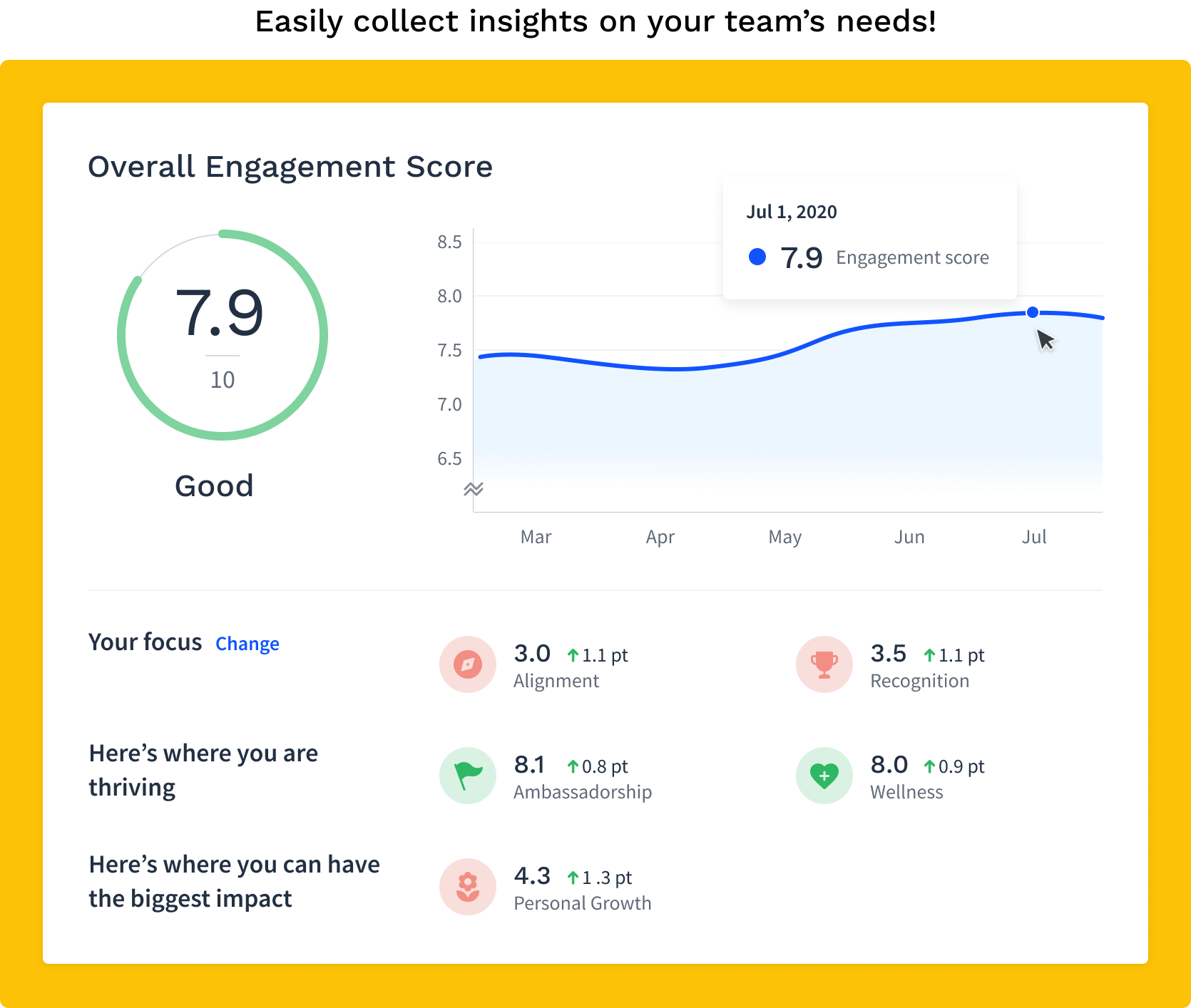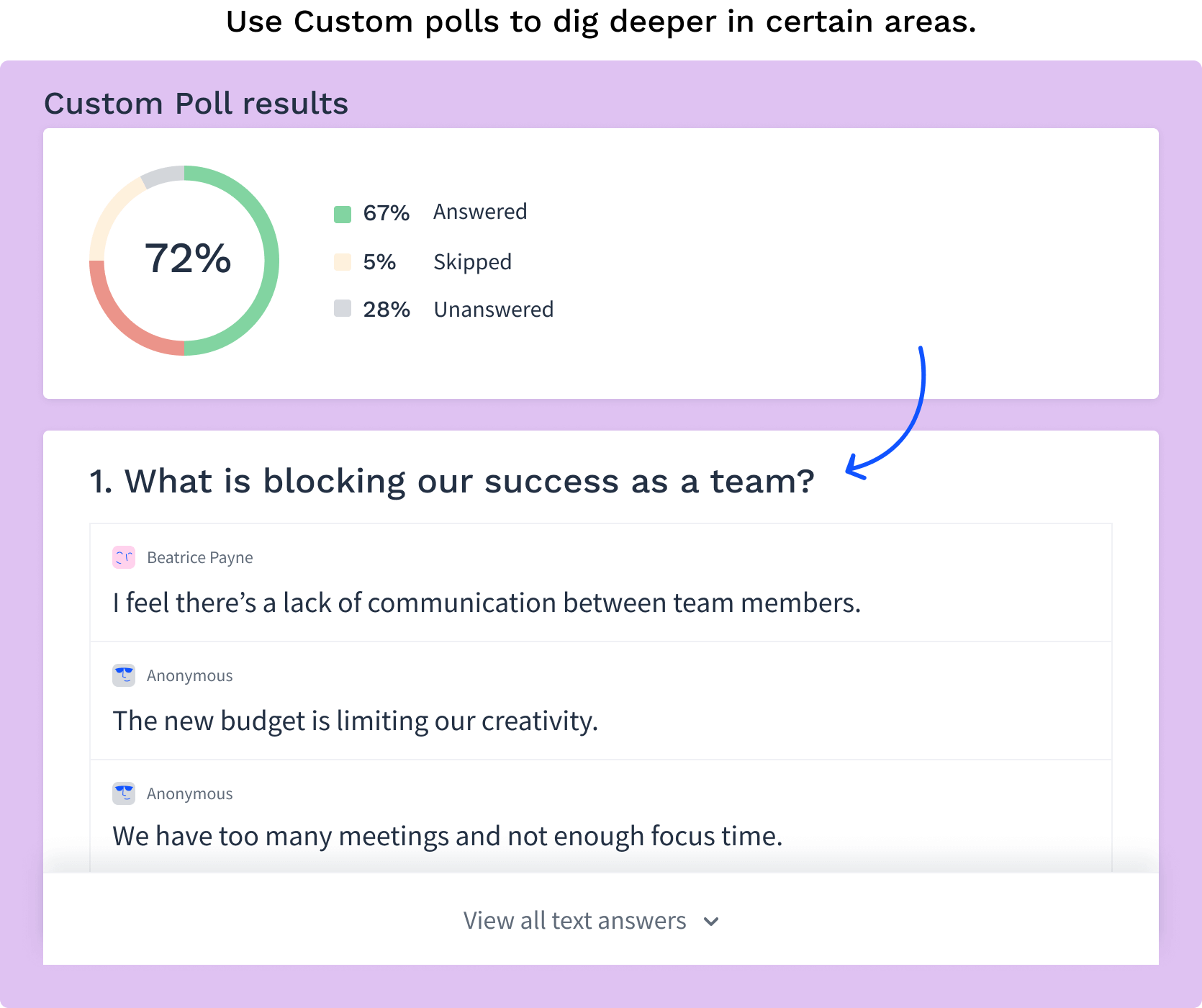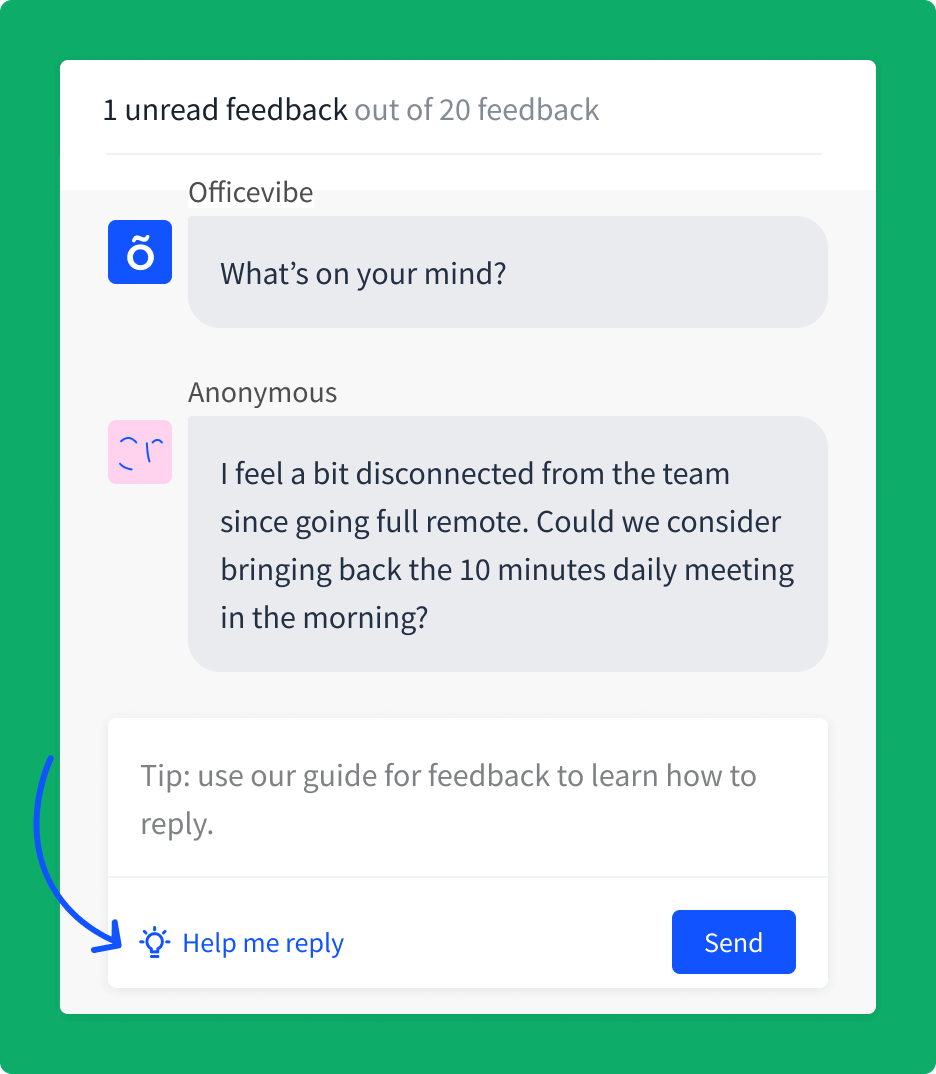Do you have a clear picture of your employees’ day-to-day, what keeps them motivated, and what their challenges are? What about their thoughts on your management style?
There has never been a better or more crucial moment for managers to check in on their people. Annual surveys have had one foot out the door for a while, but in the fast-paced virtual workforce of today, even quarterly surveys are simply not frequent enough to enable you to take action when and where it counts. The best way to leverage employee feedback is to collect it on an ongoing basis and implement small changes regularly. Pulse Surveys equip you with the digestible insights you need to have a positive impact on your team.
Assess your organization’s employee experience in minutes

In this article you’ll learn…
The purpose of an employee feedback survey
Simply put, employee feedback surveys connect the leaders of an organization with the employee experience and job satisfaction of their workforce. This helps them to adapt their company culture to improve employee engagement and drive team performance.
While survey results help HR and upper leadership adapt workplace policies and processes, they also support managers in implementing meaningful change at a team level. This is what we focus on in this article: how managers can leverage the insights they gain from feedback surveys to lead happy employees, and high-performing teams.
What do employee surveys cover?
Sending out an all-encompassing anonymous survey helps managers get a high-level picture of the health of their team. From there, you might choose to send a customized survey to get a clearer idea of employees’ sentiments on more specific topics. You can track 10 key metrics of employee engagement with Officevibe’s Pulse Survey software, and create your own custom surveys to dig deeper in certain areas as needed.

10 key metrics of employee engagement
- Relationship with manager
- Relationship with peers
- Alignment
- Satisfaction
- Wellness
- Happiness
- Recognition
- Personal growth
- Feedback
- Ambassadorship
Annual survey vs. Pulse Survey model
The trouble with annual surveys is that the infrequency makes results less relevant and useful, and manual engagement survey models pose challenges that lead to frustrations and fatigue for managers and employees alike. As Lindsey O’Sullivan, Director of People Operations at Nautilus Labs explains:
“We were running our engagement surveys through Google Forms, but also every other survey for the company. We’d wound up limiting the feedback on our engagement surveys to quarterly, because anytime you said, ‘I’m sending out a form,’ you could hear the audible groan. And then I’d chase people to fill it out, and by then, everyone was just sick of hearing about engagement.”
Pulse Surveys can reduce the frictions caused by more traditional survey models. Let’s take a look…
| Annual employee surveys | Officevibe Pulse Surveys |
| Long surveys are time consuming for employees to fill out. | Short, weekly or bi-weekly surveys fit into employees’ flow of work. |
| Added workload for managers to analyze responses. | Automated reports offer digestible, aggregated insights for managers. |
| Changes to team context over a year make results hard to compare over time. | Real-time data helps managers track trends and see the impact of initiatives and changes. |
| Issues brought up aren’t addressed in a timely manner, which can cause a lack of trust in management. | Managers can talk to their teams about issues as they arise, driving solutions and building trust. |
This final point is a crucial one: the most important outcome of employee feedback surveys is the discussions and solutions that result from them.
Are employee surveys effective?
Employee survey questions are a great way to collect concrete data on different areas of employee satisfaction and engagement on your team. But the truth is, all of the insights in the world aren’t what make surveys effective or impactful in these areas. It’s what managers do with these insights that ultimately moves the needle.
As a manager, you have a real impact on your team’s functioning, whether it’s by strengthening collaboration, building meaningful peer relationships, or supporting employee development. This is why it’s so important that you’re equipped to properly analyze employee survey results and take action where your team needs it most.
We’ve got you covered.
3 ways managers can turn survey insights into action
This is where the magic happens, where healthy team dynamics evolve and individual employees come together to form a stronger whole. Your role is making it happen, with the help of your team members. Try these exercises and practices to leverage employee survey results for the betterment of your team.
Dig deeper when changes occur
When a big change occurs or you notice an element of engagement is impacted on your team, a great first move is to dig a little deeper. Whether peer relationships are thriving or alignment is off, getting to the root cause of the shift helps you know what to amplify or maintain, or where adjustments need to be made. Send a more detailed survey (you can use Officevibe’s custom survey feature or another online survey builder) to understand what’s going on and crowd-source ideas and solutions from the team.
Specific employee survey questions
- What has changed recently in our team’s structure, dynamic, or work methods?
- What do you feel is our team’s greatest strength at the moment?
- What is blocking our success as a team?

Make it a team priority
Once you’ve pinpointed the issue or key change, bring your team members together to brainstorm solutions or ways to leverage your collective strengths. They are the best people to establish an action plan, and based on Officevibe survey results, 34% of employees do not feel appropriately involved in decisions that affect their work. Have a monthly opt-in development session with your team where you can tackle a current challenge or blocker together.
💡 Pro tip: Once you’ve established your action plan as a team, add it as an initiative in your project management software or wherever you keep track of your collective work. This will help you prioritize it as a team, and balance the importance of team development with deliverables.
Touch base individually
Especially for sensitive subjects or ones that impact certain employees more than others, you want to make time to touch base with everyone individually. Make it a talking point in your next 1-on-1 with every team member, to provide a safe space for open discussion without singling anybody out. If you feel uncomfortable or unsure how to approach these conversations, try to use open-ended questions and focus on listening.
Tactful conversation starters
- I’d like to open up a conversation around [name the subject] with the team, but I wanted to touch base with you all individually first. How do you see this impacting the team?
- I’ve noticed [name the subject] has been impacting the team’s dynamic recently. What are your observations around this?
- Do you have any ideas how we might address [name the subject] as a team?
The importance of collecting remote employee feedback
Collecting feedback from employees is especially important in a distributed workforce, where everyone is experiencing unique challenges in their individual work environment that managers might not have visibility on. Keeping a pulse on things like team alignment and employee morale helps managers stay connected with their team’s pain points, and spot any issues before they turn into problems.
With the shifting communication norms and a lack of in-person interactions from remote work, people can be even less inclined to offer feedback directly or on the fly. Creating a dedicated space for upward feedback empowers employees to share their ideas, challenges, and concerns—without cutting into your workday or waiting for their next 1-on-1.

Beyond keeping a pulse on your team with survey reports, Officevibe's employee feedback platform offers a safe space for anonymous feedback exchanges. These conversations stem from follow-up Pulse Survey prompts, Custom Poll questions, or can be initiated directly by employees with whatever’s on their mind. The more that your team sees you taking their feedback to heart and offering support where they need it, the more trust you’ll build to have these conversations directly. Extend an olive branch with Officevibe.
Try it for free.
Employee feedback surveys offer such valuable insights to managers, it’s essential to leverage them towards building more resilient, high-performing teams. When you’re equipped with accessible survey results and empowered to take action with your team, small improvements quickly come together to have a big impact.
Equip HR and managers with tools to engage, recognize, and drive performance.




